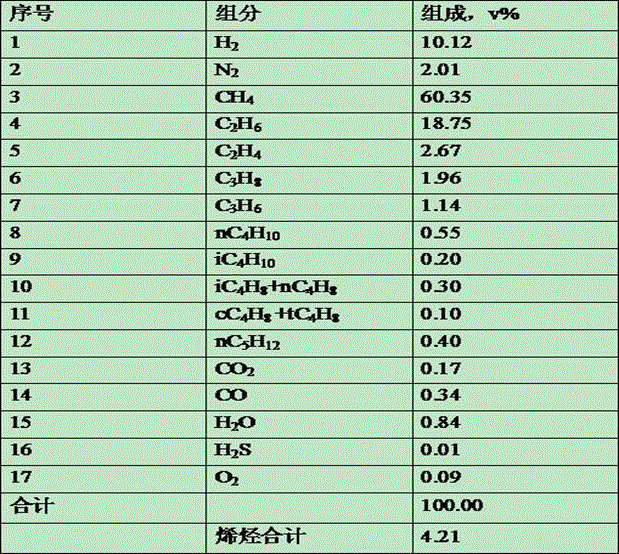Method for producing ethylene cracking feed by hydrogenation of dry gas
A technology for ethylene cracking and dry gas, which is applied in the processing of gas mixtures, the petroleum industry, and the treatment of hydrocarbon oil, etc. It can solve the problems of concentrated reaction heat release, large differences in dry gas composition, and difficulty in reaching the target for reaction products, achieving increased The effect of the reaction step
- Summary
- Abstract
- Description
- Claims
- Application Information
AI Technical Summary
Problems solved by technology
Method used
Image
Examples
Embodiment 1
[0060] A fixed-bed reactor was used for the reaction, and the feed was fed from above; the catalyst was loaded in four stages, and the loading ratio was the same as in Comparative Example 1. From top to bottom, the catalysts are A, B, C, and D in sequence. Its physical properties are listed in Table 3. The feed gas for hydrogenation is coking dry gas, and its composition is shown in Table 2. The reaction feed consisted of coker dry gas only, not distillates. The reaction conditions and results are shown in Table 5.
[0061] From the reaction results in Table 5, it can be seen that when the catalyst gradation scheme of the present invention is adopted and only a single coke dry gas feed is used for the hydrogenation reaction, the temperature rise of the reaction bed is up to 61.2°C. Compared with Comparative Example 1, the hot spot temperature has been greatly reduced; the average reaction temperature is 216.2°C, which is beneficial to prolong the service life of the catalys...
Embodiment 2
[0063] A fixed-bed reactor was used for the reaction, and the feed was fed from above; the catalyst was loaded in four stages, and the loading ratio was the same as in Comparative Example 1. From top to bottom, the catalysts are A, B, C, and D in sequence. Its physical properties are listed in Table 3. The feed gas for hydrogenation is coking dry gas, and its composition is shown in Table 2. In addition to the coking dry gas, the reaction feed also includes refined naphtha, which is fed in parallel with the coking dry gas. The main properties of refined naphtha are shown in Table 4. The reaction conditions and results are shown in Table 5.
[0064] From the reaction results in Table 5, it can be seen that after adopting the two improved methods of catalyst graded loading and introducing refined naphtha, the reaction "temperature bulb" was greatly reduced, and the reaction temperature rise was reduced from the original 110.4°C to 47.9°C ; But the average reaction temperatur...
Embodiment 3
[0072] A fixed-bed reactor was used for the reaction, and the feed was fed from above; the catalyst was loaded in four stages, and the loading ratio was the same as in Comparative Example 1. From top to bottom, the catalysts are A, B, C and D, and their physical properties are listed in Table 3. The feed gas for hydrogenation is coking dry gas, and its composition is shown in Table 2. In addition to coking dry gas, catalytic diesel is also fed into the reaction feed, which is fed in parallel with coking dry gas. The main properties of catalytic diesel are shown in Table 4. The reaction conditions and results are shown in Table 5.
[0073] From the reaction results in Table 5, it can be seen that after adopting the two improved methods of catalyst gradation loading and introducing catalytic diesel oil, the "temperature envelope" of the reaction can also be greatly reduced, and the reaction temperature rise is reduced from the original 110 °C to 45.5 °C; the average reaction ...
PUM
 Login to View More
Login to View More Abstract
Description
Claims
Application Information
 Login to View More
Login to View More - R&D
- Intellectual Property
- Life Sciences
- Materials
- Tech Scout
- Unparalleled Data Quality
- Higher Quality Content
- 60% Fewer Hallucinations
Browse by: Latest US Patents, China's latest patents, Technical Efficacy Thesaurus, Application Domain, Technology Topic, Popular Technical Reports.
© 2025 PatSnap. All rights reserved.Legal|Privacy policy|Modern Slavery Act Transparency Statement|Sitemap|About US| Contact US: help@patsnap.com



